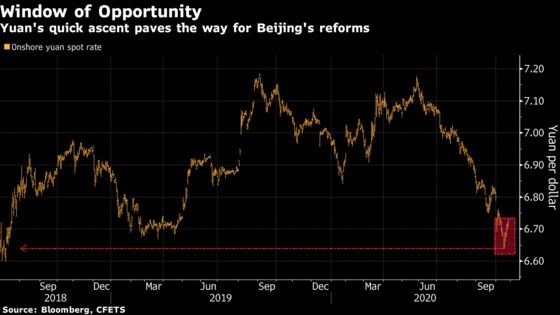China Eases Currency Controls in Move Toward Liberal Yuan
China Loosening Yuan Controls Signals Appreciation Will Endure
(Bloomberg) -- Follow Bloomberg on LINE messenger for all the business news and analysis you need.
China has taken more steps this month to loosen its grip on the yuan than at any time since curbs were imposed in the aftermath of a chaotic devaluation in 2015.
Although the changes were widely interpreted as an attempt to slow the currency’s appreciation, they have been deployed without significantly weakening the yuan or destabilizing global financial markets. Instead, the result has been a steady Chinese currency that remains near a two-year high -- potentially emboldening officials looking to push ahead with yuan reform.
A growing consensus among analysts is that the yuan has every reason to stay strong, even if appreciation happens at a slower pace from now. Higher-yielding Chinese assets will continue to attract foreign capital into mainland bond and equity markets, and the country’s economy is recovering faster from the virus pandemic than elsewhere.

Paring back control helps liberalize China’s currency market, an important component of Beijing’s long-term plan to encourage greater global usage of the yuan. Reducing China’s reliance on the U.S. dollar is increasingly pressing as tensions with Washington spill over to the financial sphere.
“The time is ripe,” said Ding Shuang, chief economist for Greater China and North Asia at Standard Chartered Plc. “Authorities are much more prepared than before, as financial regulation is more mature and fundamentals are better. The next focus for Beijing will be making it easier for capital to come in and also leave China.”
The onshore yuan rose 0.31% to 6.7084 a dollar Thursday, about 0.2% weaker than it was before the People’s Bank of China removed its rule on forwards.
Beijing’s campaign to liberalize the yuan stalled after a messy devaluation in August 2015 that triggered a vicious cycle of rapid depreciation and capital flight. The trade war triggered another round of losses from mid-2018, which eventually pushed the yuan to its weakest in more than a decade the following year.
The window for major reforms reopened this month after the yuan completed its best quarterly advance in 12 years, with an interest-rate premium that’s near the widest on record versus the dollar. That has made it more attractive to foreign capital, which is already flowing into China’s bond and equity markets due to multiple index inclusions over the past two years.
On Oct. 10, authorities said they would scrap a 20% fee imposed on traders who wished to buy certain forwards -- a type of derivative often used to bet against the yuan. Less than two weeks later, local media reported Beijing would allow domestic funds to send more capital overseas. Just days after that, some lenders stopped including a volatility-smoothening factor when submitting their reference rates, in effect removing a key control measure for the yuan.
China could do more to loosen control of the currency -- though whether further changes will happen soon is anyone’s guess. Potential measures include letting mainland investors buy offshore bonds via a trading link with Hong Kong, widening the yuan’s trading band beyond 2% either side of the fixing, or increasing the amount of dollars that residents can buy per year.
“The change is in order to enhance market-driven flexibility of the currency, which ties into the yuan internationalization goal,” Citigroup Inc. strategists led by Sun Lu wrote in a note. “The change could increase yuan volatility ahead.”
©2020 Bloomberg L.P.